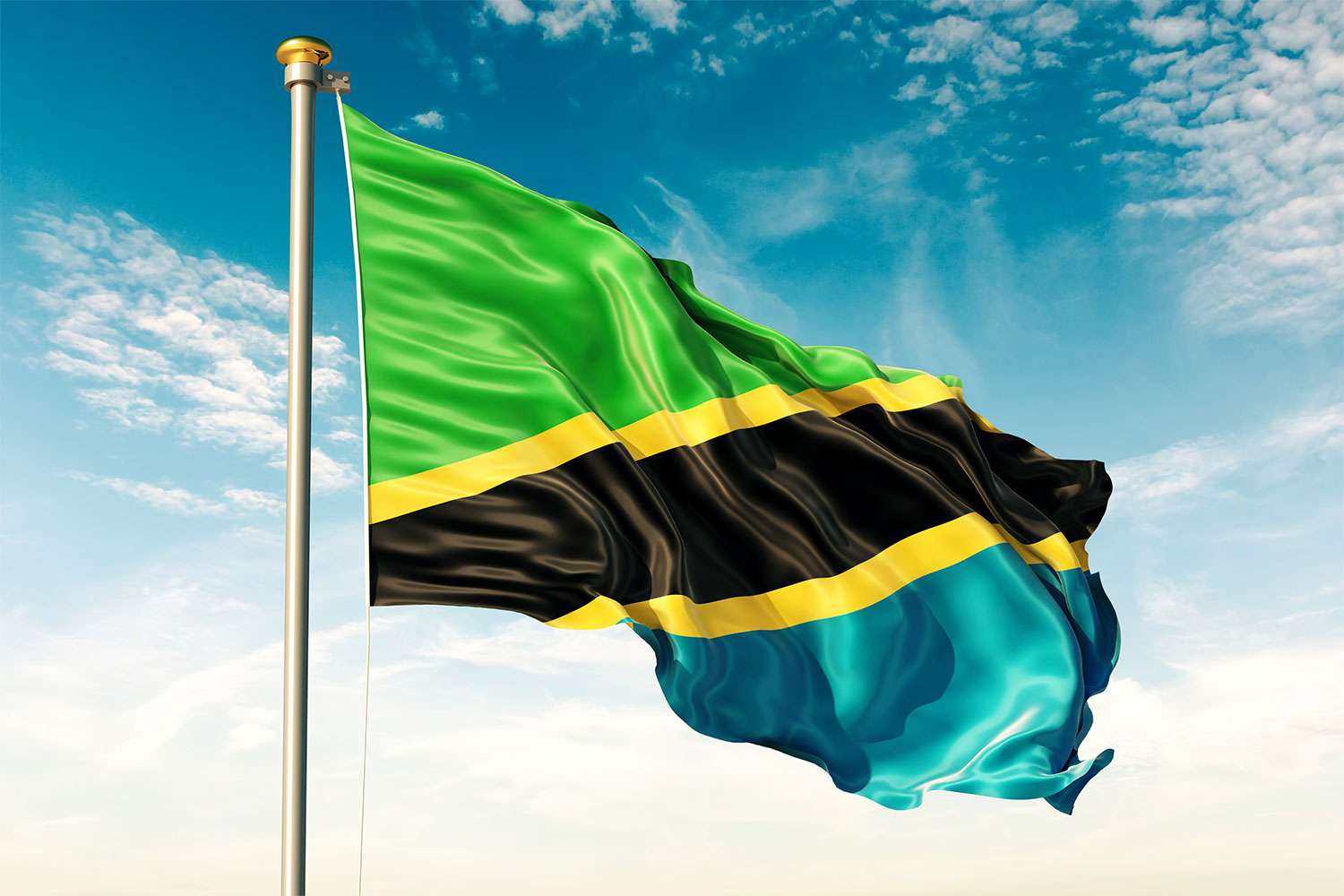Zambia’s history has gone through several phases, including colonization and British rule before independence. In the present-day country of Zambia, Northern Rhodesia came under British rule in 1888. A British protectorate was formally established in 1924. The British Federation of Rhodesia and Nyasaland was formed after years of merger proposals between Southern Rhodesia, Northern Rhodesia, and Nyasaland.
Zambia’s country was formerly referred to as Northern Rhodesia. The British South Africa Company’s flag was the first to fly in 1890. The Union Flag was damaged with the letters B.S.A.C. and a lion holding a tusk inside a circular disc. Northern Rhodesia came under direct British rule in 1924, and a British Blue ensign was established. The flag had a blue background with the union jack flying in the upper left corner and a shield with an eagle holding a fish and vertical black and white wavy lines.
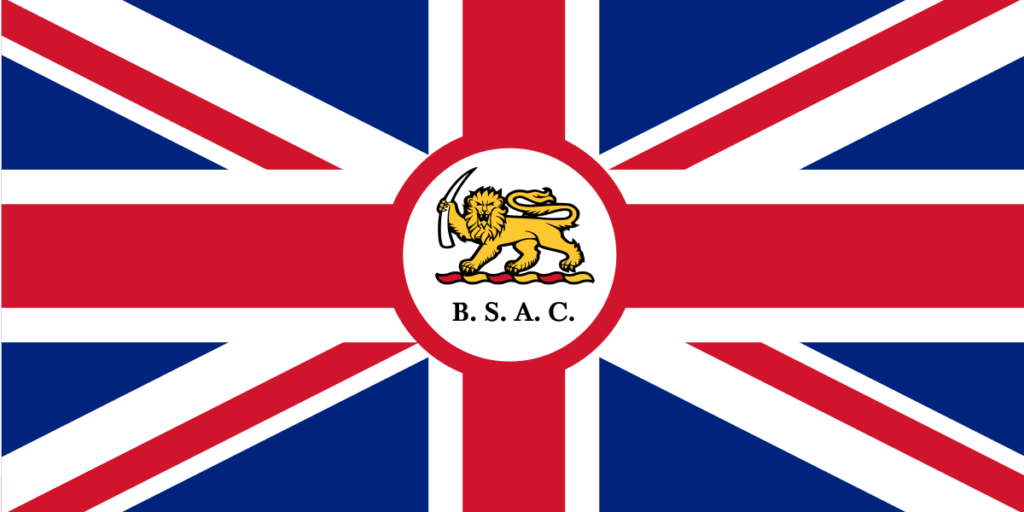
Image Source: Wikipedia

Image Source: Wikipedia
Together, Rhodesia and Nyasaland formed a self-governing British Colony in 1953. The Union flag was displayed as in the upper image of the British blue ensign for the Federation of Rhodesia and Nyasaland, which also had a shield with a rising sun, a red lion, and black and white wavy lines.
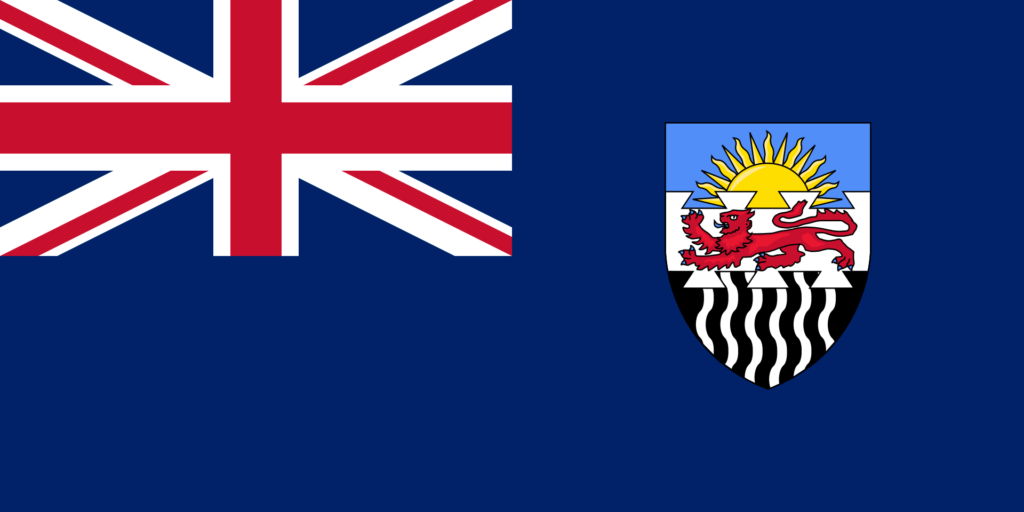
Image Source: Wikipedia
The name of North Rhodesia was changed to Zambia in 1964, and the first Republican President, Dr. Kenneth David Kaunda, adopted the national flag of Zambia on October 24, 1964, symbolizing both nationalism and riches. Prior to that, Zambia was Northern Rhodesia’s British protectorate, and its national flag was a defaced Blue Ensign.
The present flag is flown as both the ensign and the national flag. It is green with an orange African fish eagle flying above a rectangular block with three vertical stripes that are red, black, and orange in color from left to right. The eagle and block of stripes are positioned at the fly of the flag, which is unusual because most symbols and devices are positioned in the centre or at the hoist of flags.
Green symbolizes the country’s lush vegetation, red the country’s struggle for independence, black the Zambian people, and orange the wealth of the land’s natural resources and minerals. The eagle flying over the colored stripes is also meant to symbolize the power of the populace to overcome the issues facing the country.
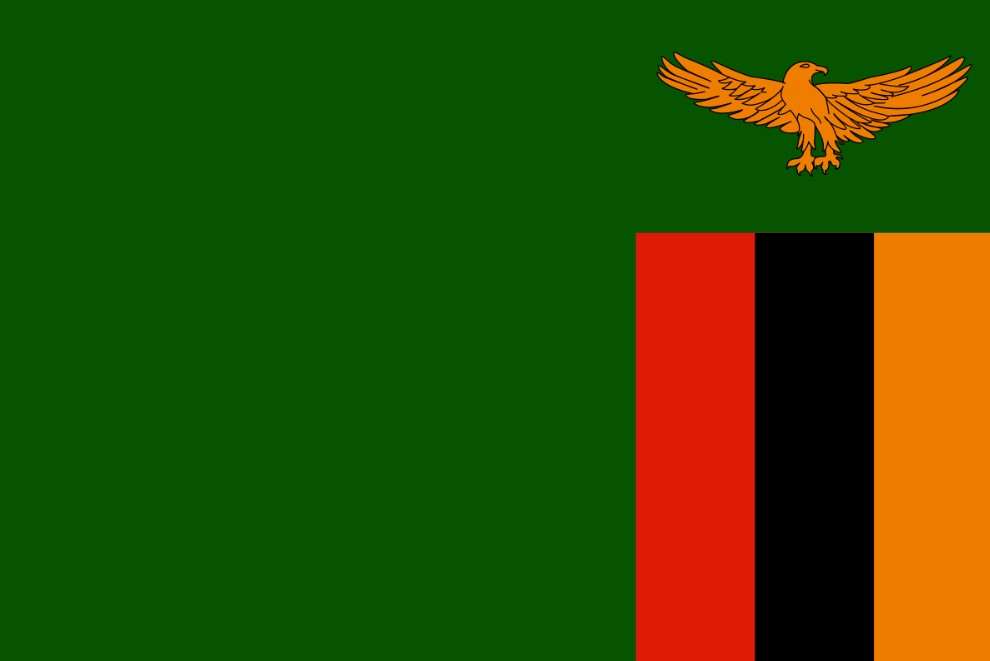
Image Source: Wikimedia Commons
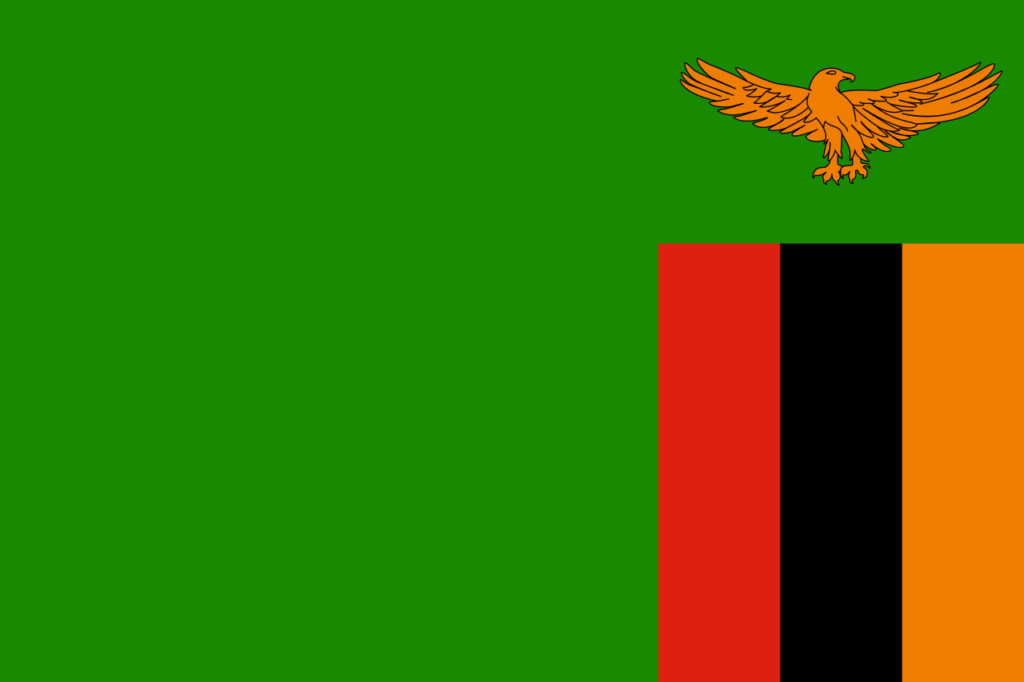
Image Source: Wikimedia Commons
In 1996, a small change was made to the Zambian flag. The 1964 flag’s green color was changed to a brighter, lighter tone, and the eagle’s design was somewhat modified to resemble Zambia’s coat of arms more closely.
Design
Mrs. Gabriel Ellison, OGDS, MBE, who also created the Zambian coat of arms, carefully considered, and developed the Zambian Flag. The Zambian flag uses four distinct colors. The color green, which represents a field, also represents the country’s fertile soil. In the lower right corner, there are three vertical stripes. Red represents the struggle for independence. The national people are represented by the color black. The country’s mineral richness and plethora of natural resources are symbolized by the orange stripe. As indicated earlier, the orange-colored eagle that is situated above the stripes symbolizes the residents’ capacity to overcome the challenges that the nation has experienced over the years and into the future.
Meaning of the Flag
The Zambian flag features hues and images that are deeply meaningful to the country. The eagle on the flag is designed to symbolize the power of the populace to overcome the issues facing the country. The rectangular block of vertical stripes signifies the struggle for freedom, the Zambian people, and the country’s natural resources, while the field represents the flora of Zambia. In contrast to other national flags, which retain their emblems and symbols in the centre or on the hoist side, what is most striking about this country’s flag is the placement of the eagle and vertical stripes.
Coat of arms of Zambia
When the Republic of Zambia attained independence on October 24, 1964, the coat of arms of Zambia was adopted. This coat of arms is an adaptation of the 1927 British protectorate of Northern Rhodesia’s coat of arms, which had an eagle that was then carrying a fish in the chief and wavy black and white vertical lines as the field.
The African fish eagle stands for the nation’s future aspirations and the victory of freedom. The agricultural and mining sectors of the economy, as well as the traits that have shaped Zambia’s evolution and nature, are symbolized by the hoe and pickaxe. The Victoria Falls, with its white water pouring over its dark rock, are shown on the shield. Zambia gets its name from the Zambezi River, which is represented by the Victoria Falls. The Zambian coat of arms also features symbols for the country’s natural riches, including agriculture, wildlife, and mining. Two figurines that stand in for the nation’s average man and woman are holding up the shield. One Zambia, One Nation is the country’s motto, emphasizing the need for unity in a nation with over 72 different ethnic groups.
The Federation of Rhodesia and Nyasaland’s coat of arms, which was in use from 1954 to 1963, used the same wavy black and white vertical lines on the shield.
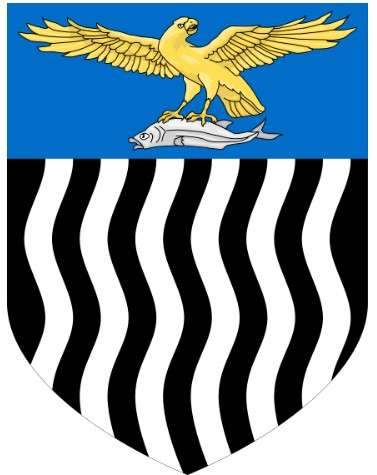
Image Source: Wikimedia Commons
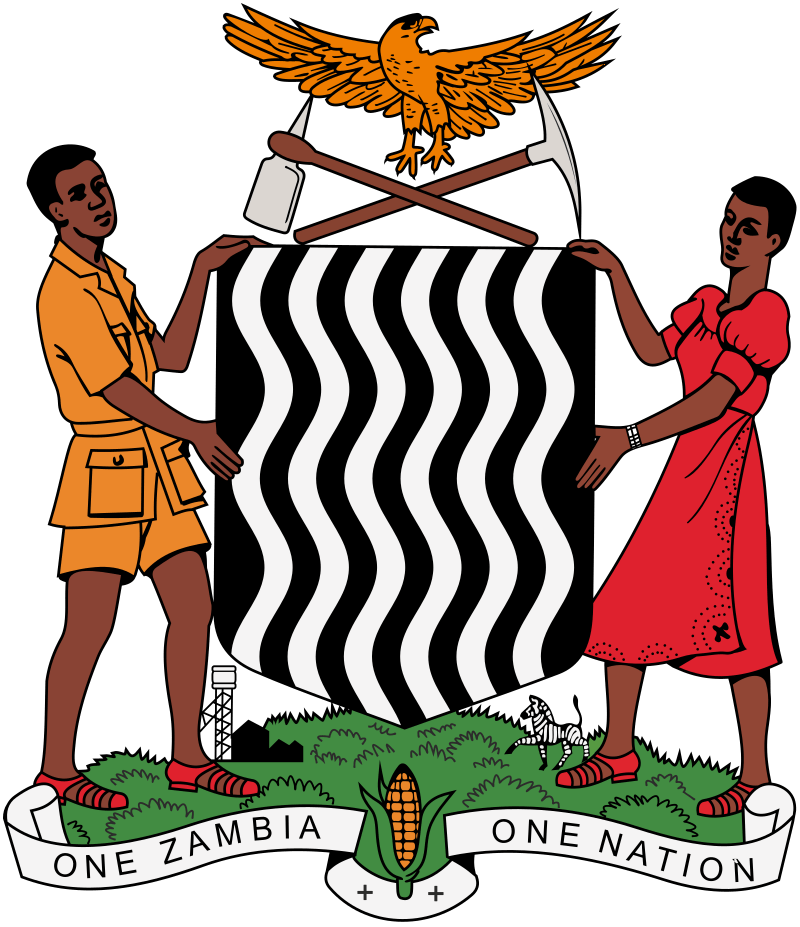
Image Source: Wikipedia
Controversies around Zambia Flag: Defaced Zambian Flag
Now-a-days, the national flag of Zambia is not actually what is flying or what is displayed on the flagstaffs of several governments or even ministerial offices. Since there are apparently national flags flying on the institutional flag masts, it appears that the importance of raising a full and correct flag is waning at many of these public organizations. ‘Supposedly’ in the sense that the key symbolic elements, such as the eagle and other colors, have been completely stripped off of these flags.
A national flag at the Ministry of Tourism and Arts offices on Lusaka’s main Cairo Road and the one at the Government Printers on Church Road are two good examples. Some of these “flags” might only be flown in green. This raises the question of why the majority of public entities appear to ignore the wearing of the flag at their locations.
It hurts me to see damaged and mutilated flags flying above public and governmental buildings, says veteran lawmaker and independence warrior Vernon Mwaanga. Everywhere we go in the globe, we are recognized as Zambians thanks to this sense of national identity. It merits a lot of consideration and attention. The flag in every government building must be raised at six in the morning and down at eight in the evening, except for hotels and other locations where business is conducted overnight.
To their surprise, the correct Zambian national flags are now displayed on the office holder’s table when authorities visit these institutions’ offices.
One wonders if the officeholder would accept a torn flag on the table that was identical to the one on the main mast. Would he or she keep quiet about it, or would they demand a replacement right away?
Only those with access to the office can see the correct table flag next to an office bearer. If a significant government agency is observed using a ripped flag lacking major elements like the eagle and two other iconic colors on it, there is immediate concern about the availability and cost of the flags.
Could it be that the authorities at these public organizations never get to notice the good flags because of their insufficiency or cost?
Yamfwa Mukanga, minister of works and supply, claims there is no justification for any government office or public institution, such as a school or hospital, to be using a tattered flag as there are enough fresh flags readily available for delivery at his Ministry.
“I don’t see why we should keep seeing worn-out flags when we have flags here at the ministry ready to be collected, or perhaps I should say I don’t see any justification for it. All government agencies and public institutions should ensure they visit the ministry to pick up the flags because they are a national emblem”, he says. The Ministry of Works and Supply has enough flags, according to Mr. Mukanga, unless an institution wishes to purchase a flag of a certain quality on its own.
Worryingly, the current generation’s perception is losing the fundamental essence of national identity may be seen in how they currently treat their country’s flag. Now, the government has started taking adequate steps to change the way the Zambian citizens, especially those in public offices perceive the national flag as it contributes a lot to the marketing of Zambia’s tourism and Zambia as a whole.
By: Jasleen Kaur


